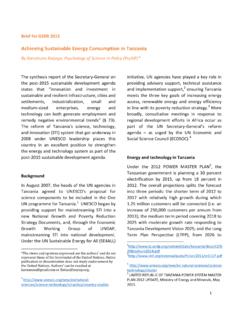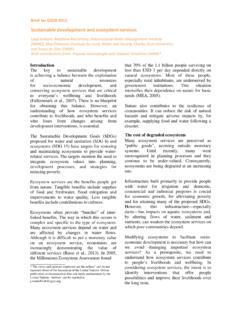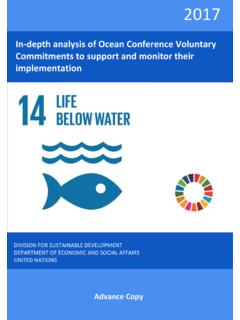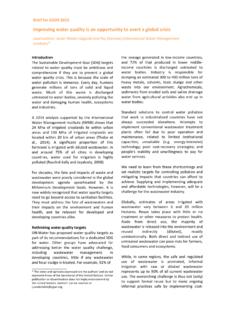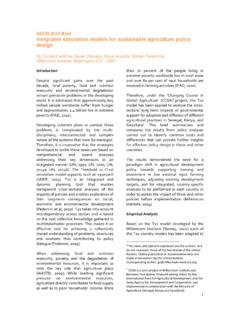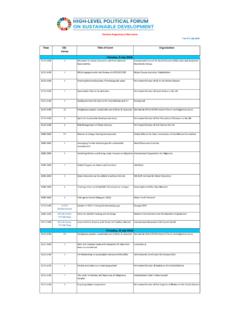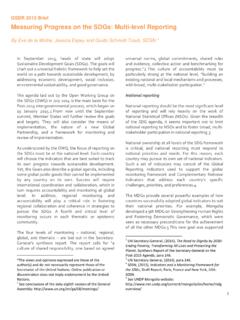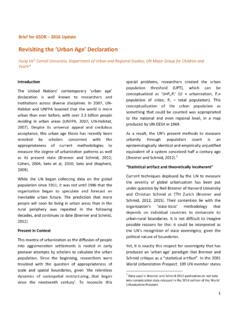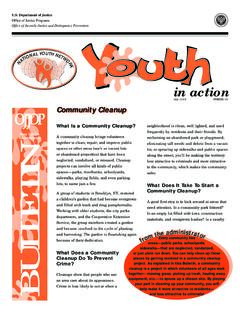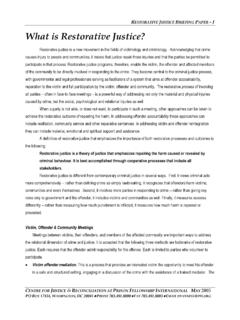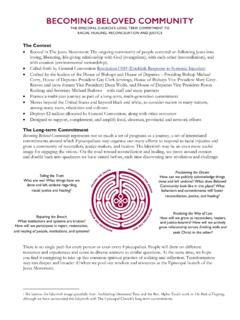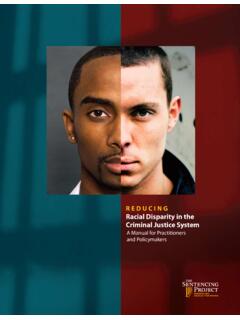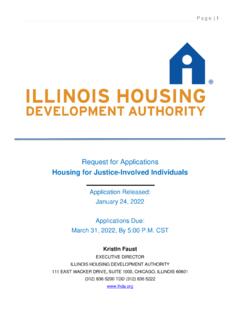Transcription of Literature Review Sustainable Development Approaches for ...
1 I Literature Review Sustainable Development Approaches for Rural Development and Poverty Alleviation & community Capacity Building for Rural Development and Poverty Alleviation Christian R. Bueno Montaldo background paper for community Capacity Building and Rural Governance as part of the Master Program on Rural Society Leadership Development for Global Poverty Reduction May 2013 Wonju ii Table of Contents List of Abbreviations iii 1. Sustainable Development Approaches for rural Development and poverty Alleviation. 1 History of Sustainable Development and its significance to Rural Development . 1 Theoretical and conceptual frameworks of Sustainable Development . 2 Key policy goals and dimensions of Sustainable Development . 3 What have been accomplished, challenges and barriers in implementing SD goals 4 Major institutions and players that should be transformed. 6 Key policy recommendations for Sustainable Development .
2 7 Implications of Sustainable Development in Peru 8 2. community Capacity Building for Rural Development and Poverty Alleviation 9 Sustainable community capacity building 9 ABCD concepts and model to support Sustainable rural Development 10 Case of ABCD in community Development project: United we can. 11 Accomplishments and challenges of ABCD model. 12 References 13 iii List of Abbreviations ABCD Asset based community Development CCB community Capacity Building CSD Commission on Sustainable Development FEEM Fondazione Eni Enrico Mattei GSG Global Scenario Group IIASA - GEA Global Energy Assessment MDG Millennium Development Goals OECD Organization for Economic Cooperation and Development PBL PBL Netherlands Environmental Assessment Agency SD Sustainable Development SDG Sustainable Development Goals SEI Stockholm Environment Institute UN United Nations UNCED United Nations Conference on Environment and Development UNDESA United Nations Department of Economic and Social Affairs UNEP United Nations Environment Programme UNESCO United Nations Educational, Scientific and Cultural Organization UNRISD United Nations Research Institute for Social Development WCED World Commission on Environment and Development 1 1.
3 Sustainable Development Approaches for rural Development and poverty alleviation. History of Sustainable Development and its significance to Rural Development . Although the origins of Sustainable Development (SD) can be traced to the seventies, is in the World Commission on Environment and Development in 1987 (WCED or Brundtland Commission ) that the term is coined and also defined as Development that meets the needs of the present without compromising the ability of future generations to meet their own needs (Le Blanc, D., et al. 2012:1). One of the defining moments for SD was the UNCED, known as the Earth Summit , held in Rio de Janeiro in 1992 with the agreement by member States to launch a process to develop a set of Sustainable Development goals (SDGs) that could be a useful tool for pursuing focused and coherent action on Sustainable Development (United Nations 2012:15; Le Blanc, D.)
4 , et al. 2012:17). But why Sustainable Development is significant for rural Development ? Poverty remains a predominantly rural problem, with a majority of the world s poor located in rural areas (Dercon, S. 2009), it is estimated that 76 percent of the developing world s poor live in rural areas, well above the overall population share living in rural areas, which is only 58 percent (Janvry, A. de, E. Sadoulet, and R. Murgai 2002; Giovannucci, D., et al. 2012:6). Poverty greatly limits the quantity and quality of food that people can purchase. Workers in developing countries often make only $1 - 2 per day, with relatively less money in those regions, the economic demands for food is less, which in turn results in lower levels of either food production or distribution (Sheaffer, C. and 2 Moncada, K. 2009:68-70). In the other hand environmental limitations like soil resources, water and energy turn more difficult the scenario of rural area.
5 Theoretical and conceptual frameworks of Sustainable Development . The Rio Declaration on Environment and Development is the cornerstone of Sustainable Development , a set of 27 principles promoted concepts such as the centrality of human beings to the concerns of Sustainable Development (Principle 1); the primacy of poverty eradication (Principle 5); the importance of the environment for current and future generations and its equal footing with Development (Principles 3 and 4); the special consideration given to developing countries (Principle 6); the principle of common but differentiated responsibilities (CBDR, Principle 7). It also enshrined the two critical economic principles of polluter pays (Principle 16) and the precautionary approach (Principle 15). It introduced principles relating to participation and the importance of specific groups for Sustainable Development (Principles 10, 20, 21, 22) (Le Blanc, D.)
6 , et al. 2012 :1). Twenty years later was celebrated the United Nations Conference on Sustainable Development (Rio+20), held in Rio de Janeiro in June 2012, was the agreement by member States to launch a process to develop a set of Sustainable Development goals (SDGs) that could be a useful tool for pursuing focused and coherent action on Sustainable Development . Other frameworks like the Millennium Development Goals (MDG), are a clear demonstration that world leaders can come together to address the major challenges of our time not only war and financial crisis, but also poverty (UNRISD 2010:3; Le Blanc, D., et al. 2012 :16). 3 A difference between the MDGs and the SDGs is the degree of agreement that exists among countries on the broad underlying objectives, as well between the contexts of the MDGs and the SDGs is the prevalence of collective action problems at the heart of Sustainable Development , and the frequent failure of countries at solving those problems (Le Blanc, D.
7 , et al. 2012:17-20). Key policy goals and dimensions of Sustainable Development . High-level Panel on Global Sustainability of UN in 2012, establish the most uniform and consistent Review of principles related with any framework related with SD: It should be universal in character, covering challenges to all countries rather than just developing nations. It should express a broadly agreed global strategy for Sustainable Development . It should incorporate a range of key areas that were not fully covered in the MDGs It should be comprehensive, reflecting three dimensions of SD It should incorporate near-term benchmarks while being long-term in scope, looking ahead to a deadline of perhaps 2030. It should engage all stakeholders in the implementation and mobilization of resources It should provide scope for the Review of these goals in view of evolving scientific evidence.
8 In the other hand, during the present research the task to identify a set of measurable indicators was difficult. Because indicators are elaborated starting from the dimensions of Sustainable Development I found out that there is no uniform criterion among organizations of the number and types of dimensions. 4 In Agenda 21, article states that countries could develop systems for monitoring and evaluation of progress towards achieving Sustainable Development by adopting indicators that measure changes across economic, social and environmental dimensions (United Nations 1992:Art. ), ironically in further documents UN considers institucionality like a fourth dimension (United Nations 2007:39-40). UNESCO considers three dimensions of Sustainable Development named before and also political dimension (democracy, politics, decision making). Jon Hawkes in his book The Fourth Pillar of Sustainability: Culture's essential role in public planning , contributes with Cultural dimension for SD, states if a society s culture disintegrates, so will everything else.
9 Cultural action is required in order to lay the groundwork for a Sustainable future. What have been accomplished, challenges and barriers in implementing SD goals The High-level Panel on Global Sustainability also elaborated a comprehensive analysis about the progress in Sustainable Development , main indicators are described: Economic growth and inequality: last decades the world s overall GDP grew by 75 per cent, however inequality has grown continuously. Poverty eradication: the world is comfortably on track to beat the MDG. Forests: the rate of deforestation has decrease; however, the world is still losing forest cover at an alarming rate. Oceans resources: overfishing now being classified as overexploited, or fully exploited, a situation substantially worse than two decades ago. Climate change: annual global CO2 emissions grew 38 per cent between 1990 and 2009 and would lead to a likely temperature increase 5 Biodiversity and ecosystems: evidence show that most habitats are in decline and the rate of species extinction appears to be accelerating.
10 Gender: women have seen substantial improvements in rights, education, health, and labor opportunities, but there are still persistent differences across all societies. Education: remarkable progress has been made in education worldwide. Globally, literacy rates are improving, but progress is slow. Hunger: global food production has kept pace: today enough food is produced to feed all of us comfortably; however, access to food is another story. The last decades were characterized by dramatic changes in technology that has influenced other spaces of the science, customs and cultural relations, and collateral effects in the environment, that creates new scenarios and challenges: Environmental and Social Costs of the Green Revolution (Institute for Food and Development Policy 2009). Climate change: is a risk to all countries and individuals. Environmental degradation: expressed as loss of fertile soils, desertification, unsustainable forest management, etc.

